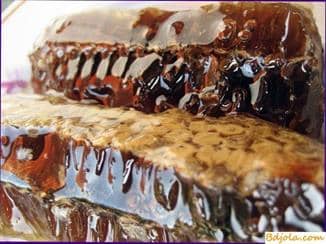Padewood honey

In our country, bees often collect a drop of animal origin, which is significantly different from nectar. Bee bees are processed into beehives in the same way as nectar. When the water content in the honey falls to normal size, the bees seal it in the cells with wax lids. It is noticed that honey bees seal the honey beet much later than the nectarean honey. The abundance of cells with unsealed honey in the autumn is one of the signs of the presence of honeycombs in honeycombs. Padew honey can be light brown, brown and dark in color. Light honey is rare: honey is collected only in the spring and in the first half of the summer. Sometimes, padom honey is greenish-dark in color (for example, from aphids on oak).
Distinctive features of pade honey are its viscosity, viscidity and lack of a “honey” smell, although honey is very sweet, but without the specific taste of nectar honey. Some honey have a distinct taste, reminiscent of malt.
Most often in the process of processing bees are mixed with honey to the nectarean honey and such mixed honey in appearance can not be distinguished from the natural (nectarean).
Pade honey crystallizes into a fine-grained soap-like mass, sometimes with a large sludge of the liquid fraction. Honeydew honey is more hygroscopic than nectarean, and quickly sour, especially after pumping out of cells not sealed with bees.
The chemical composition of honeydew honey is very diverse and depends on the type of insect panther, on the species of plants, on the time of bee collection by bees, on meteorological conditions and on the microflora developing in the paddock before collection by bees (Table 12).

As can be seen from Table 12, pade honey has fewer inverted sugars (monosaccharides), much more disaccharides (sugar not processed by bees), organic acids. It contains 3 times
Pad, in contrast to nectar, does not contain phytoncides and other antibiotic substances that protect against the development of microorganisms. Therefore, during the stay on the leaves of plants the microflora, which changes its composition and introduces substances harmful to bees, develops freely in the padi. By the evening, the transparent one becomes dark. In such cases, the bees that feed on the fall reduce life expectancy and often lead to massive death. VI Poltev called this disease a pandemic toxicosis.
A drop of animal origin inevitably contains substances harmful to bees, formed as a result of protein metabolism in aphids. When feeding the bees with a pad, collected from the leaves of different trees, the bees live less. So, in the experience, bees in cages, fed with floral honey, lived 19 days, fed sugar syrup – 18.5 days, fed a drop from the rose hips and plums – 8, a fall from the linden and aspen – 5,5, with oak – 4,5 day.
Bees, obviously, and themselves feel the inadequacy of nutrition with padeal honey, so they never collect a drop if there are flowering nectariferous plants in nature. The bees are comparatively rare in spring and in the first half of summer. A small admixture of padi to nectar honey does not cause a significant harm to bee families if bees can almost daily fly and be freed from excrement.
Only in the autumn, when the nectar release of plants completely ceases, and the number of aphids reaches a maximum, the bees collect a copious discharge that remains for their feeding in winter. And if the admixture of padi to nectar honey is large enough, the bees get diarrhea. Only the replacement of poor quality honey with good or sugar can protect the bees from disease and death.
Padewood honey
